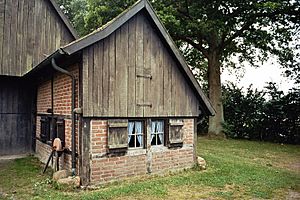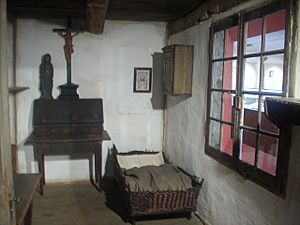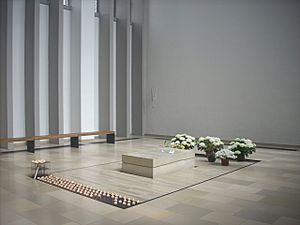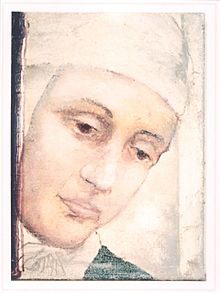Anne Catherine Emmerich facts for kids
Quick facts for kids BlessedAnne Catherine Emmerich |
|
|---|---|
 |
|
| Virgin, Penitent, Marian Visionary and Stigmatist | |
| Born | 8 September 1774 Flamschen, Coesfeld, Prince-Bishopric of Münster, Holy Roman Empire |
| Died | 9 February 1824 (aged 49) Dülmen, Kingdom of Prussia, German Confederation |
| Venerated in | Roman Catholic Church |
| Beatified | 3 October 2004, St. Peter's Basilica, Vatican City by Pope John Paul II |
| Feast | 9 February |
| Attributes | Bedridden with bandaged head and holding a crucifix |
Anne Catherine Emmerich (also Anna Katharina Emmerick; 8 September 1774 – 9 February 1824) was a Roman Catholic Augustinian nun. She was known as a mystic, someone who had special spiritual experiences. She also had visions of the Blessed Virgin Mary and experienced stigmata, which are marks like the wounds of Jesus.
She was born in a small farming village called Flamschen, near Coesfeld, in Germany. She passed away at age 49 in Dülmen, where she had lived as a nun and later became very ill. People believed Anne Catherine had visions about the life and suffering of Jesus Christ. She said these visions were shown to her by the Virgin Mary during deep spiritual trances.
When she was sick in bed, many famous people came to visit her. A poet named Clemens Brentano talked to her a lot and wrote books based on what she told him about her visions. However, some people have wondered if Brentano's books were truly her words. Critics have even said the books might be "made up by a poet."
Pope John Paul II declared Anne Catherine Emmerich "Blessed" on 3 October 2004. The Vatican focused on her deep faith and good life, rather than the religious writings linked to her by Clemens Brentano.
Contents
Early Life and Becoming a Nun
Anne Catherine Emmerich grew up in a family of poor farmers. She had nine brothers and sisters. From a young age, she helped with chores around the house and farm. She didn't go to school for very long, but everyone who knew her saw that she loved to pray. When she was twelve, she started working on a large farm for three years. Later, she learned to sew and worked as a seamstress.
She wanted to become a nun, but many convents turned her away because she didn't have enough money to join. Finally, a group of nuns called the Poor Clares in Münster agreed to accept her. But first, she had to learn to play the organ. She went to an organist named Söntgen to study music. However, the Söntgen family was very poor, so Anne Catherine worked for them and used her own small savings to help them. Later, one of the Söntgen daughters joined the convent with her.
Joining the Convent
In 1802, when Anne Catherine was 28, she and her friend Klara Söntgen finally became Augustinian nuns at the Agnetenberg convent in Dülmen. The next year, Anne Catherine made her official promises to God as a nun. In the convent, she was known for strictly following the rules of her order. But from 1802 to 1811, she was often very sick and in a lot of pain. Sometimes, her strong faith and strict rules bothered some of the other nuns. They were confused by her poor health and her spiritual trances.
In 1812, the convent was closed down by the king. Anne Catherine found a new home with a widow.
The Stigmata and Investigations
In early 1813, people noticed marks on Anne Catherine's body that looked like the stigmata. These are marks similar to the wounds Jesus had on the cross. Her local priest asked two doctors to examine her. Three months later, when news of these marks spread, the priest told the church leaders.
Because the news caused a lot of talk in the town, church officials started a long investigation. Many doctors wanted to examine her. Even though efforts were made to keep curious people away, some important visitors were allowed to see her. During this time, the poet Clemens Brentano first came to visit.
By the end of 1818, the bleeding from Anne Catherine's hands and feet stopped, and the wounds closed. Many people in the community believed the stigmata were real. But others thought Anne Catherine was faking it, working with her friends to trick people. In August 1819, the government stepped in. They moved Anne Catherine to a different house and watched her for three weeks. The people investigating her couldn't find any proof that she was faking. They had different ideas about what was happening.
Visions and Their Impact
Anne Catherine said that even as a child, she had visions. She claimed to talk with Jesus, see souls in a place called purgatory, and witness the center of the Holy Trinity (God the Father, Son, and Holy Spirit) as three bright, connected spheres. The largest sphere was the Father, the middle was the Son, and the smallest and brightest was the Holy Spirit.
The books written by Brentano say that when Anne Catherine was sick as a child, a child (who she believed was Jesus) visited her. He told her about plants she should eat to get better.
Anne Catherine had many mystical visions that she talked about. For example, she wrote about a "Mount of Prophets," which she said was the Himalayas. She believed people like Enoch and Elijah, who didn't die in the usual way, lived there. She also thought animals that survived the Great Flood could be found there. Some people think she was seeing a legendary spiritual place mentioned in many ancient stories, where special or immortal beings go.
Because of Anne Catherine's growing reputation, many important people from the Church's renewal movement in the early 1800s came to visit her. These included future Archbishop of Cologne Clemens August von Droste zu Vischering and Bishop Johann Michael Sailer. Clemens von Droste called Anne Catherine "a special friend of God."
Clemens Brentano's Writings
When Anne Catherine was being investigated a second time in 1819, Brentano visited her. He said she told him that he was sent to help her write down the special messages she received from God. Brentano became one of her biggest supporters, believing she was a "chosen Bride of Christ."
From 1819 until Anne Catherine's death in 1824, Brentano filled many notebooks with stories of her visions. These visions included scenes from the New Testament and the life of the Virgin Mary. Anne Catherine only spoke a local German dialect, so Brentano couldn't write down her words directly. He would quickly write notes in standard German after he left her room, based on what he remembered. Brentano later edited these notes, years after Anne Catherine had passed away.
About ten years after Anne Catherine shared her visions, Brentano finished preparing his notes for publishing. In 1833, he released his first book, The Dolorous Passion of Our Lord Jesus Christ According to the Meditations of Anne Catherine Emmerich. Brentano then started working on The Life of the Blessed Virgin Mary from the Visions of Anna Catherine Emmerich, but he died in 1842 before it was finished. The book was published after his death in 1852.
Another Catholic priest, Karl Schmoger, edited Brentano's writings. From 1858 to 1880, he published three volumes of The Life of Our Lord. Schmoger also wrote a two-volume biography of Anne Catherine Emmerich.
The Vatican does not officially say that the books written by Brentano are completely true. However, they see their general message as "a great way to share the gospel for people's salvation." Other critics have been less kind, saying the books Brentano produced were "made up by an overly emotional romantic poet."
Brentano wrote that Anne Catherine believed that Noah's son Ham was the ancestor of "the black, idol-worshipping, simple nations" of the world. Some also claim that the "Dolorous Passion" book contains negative ideas about Jewish people.
Questions About Brentano's Work
When the request to make Anne Catherine a saint was sent to the Vatican in 1892, experts in Germany started comparing Brentano's original notes with the books he had published. They found other old Bible stories, maps, and travel guides among his papers. This suggested he might have used these to add details to Anne Catherine's stories.
In 1923, a German priest named Winfried Hümpfner compared Brentano's original notes to the published books. He wrote that Brentano had made up a lot of the material he said came from Anne Catherine.
By 1928, experts concluded that only a small part of Brentano's books could truly be said to come from Anne Catherine.
When Anne Catherine was declared "Blessed" in 2004, a priest named Peter Gumpel, who worked on her case for the Vatican, explained their position. He said, "It is absolutely not certain that she ever wrote this. There is a serious problem of authenticity." According to Gumpel, the writings linked to Anne Catherine were "absolutely set aside" by the Vatican during her beatification process.
Death and Burial
Anne Catherine became weaker during the summer of 1823. She died on 9 February 1824 in Dülmen. She was buried in the graveyard outside the town, and many people attended her funeral. Her grave was opened twice in the weeks after the funeral because of a rumor that her body had been stolen. However, her coffin and body were found to be untouched.
In February 1975, Anne Catherine's remains were moved to the Holy Cross Church in Dülmen, where they are kept today.
House of the Virgin Mary
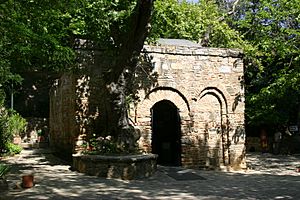
Neither Brentano nor Anne Catherine had ever visited Ephesus in Turkey. In fact, the ancient city had not even been fully dug up yet. However, visions described in Brentano's book The Life of The Blessed Virgin Mary were used to help find the House of the Virgin Mary. This house is believed to be where the Virgin Mary lived before she was taken up to heaven. It is located on a hill near Ephesus.
In 1881, a French priest named Abbé Julien Gouyet used Anne Catherine's book to search for the house in Ephesus. He found it based on the descriptions. At first, people didn't take him seriously. But another nun, Sister Marie de Mandat-Grancey, kept pushing until two other priests followed the same path and confirmed the discovery.
The Holy See (the Pope's main office) has not officially said if the location is truly authentic. However, in 1951, Pope Pius XII declared the house a Holy Place. Later, Pope John XXIII made this declaration permanent. Pope Paul VI in 1967, Pope John Paul II in 1979, and Pope Benedict XVI in 2006 all visited the house and treated it as a special holy site.
Becoming "Blessed"
The process to make Anne Catherine a "Blessed" person (a step towards sainthood) began in 1892 by the Bishop of Münster. However, in 1928, the Vatican stopped the process. This was because it was suspected that Clemens Brentano had made up some of the material in the books he wrote and said came from Anne Catherine.
In 1973, the Congregation for the Causes of the Saints (a Vatican department) allowed her case to be reopened. But they said it could only focus on her own life and good deeds, without using any of the material that might have been changed by Clemens Brentano.
In July 2003, the Congregation for the Causes of the Saints announced that a miracle had been attributed to her. This paved the way for her beatification.
On 3 October 2004, Anne Catherine Emmerich was declared "Blessed" by Pope John Paul II. However, the books produced by Brentano were not used in this decision. Her beatification was based only on her own personal holiness and good character.
Movies About Her Life
In 2003, actor and director Mel Gibson used Brentano's book The Dolorous Passion as a main source for his 2004 film The Passion of the Christ. Gibson said he only used the Bible and "accepted visions" as his sources. If you read Brentano's book carefully, you can see how much the movie relied on it.
In 2007, German director Dominik Graf made a movie called The Pledge. This film shows the meetings between Anne Catherine Emmerich (played by actress Tanja Schleiff [de]) and Clemens Brentano. The movie is based on a novel by Kai Meyer.
See Also
 In Spanish: Ana Catalina Emmerick para niños
In Spanish: Ana Catalina Emmerick para niños
- Alexandrina of Balazar
- Maria Valtorta
- Marthe Robin
- Maria Domenica Lazzeri
- Marie Rose Ferron
Images for kids


